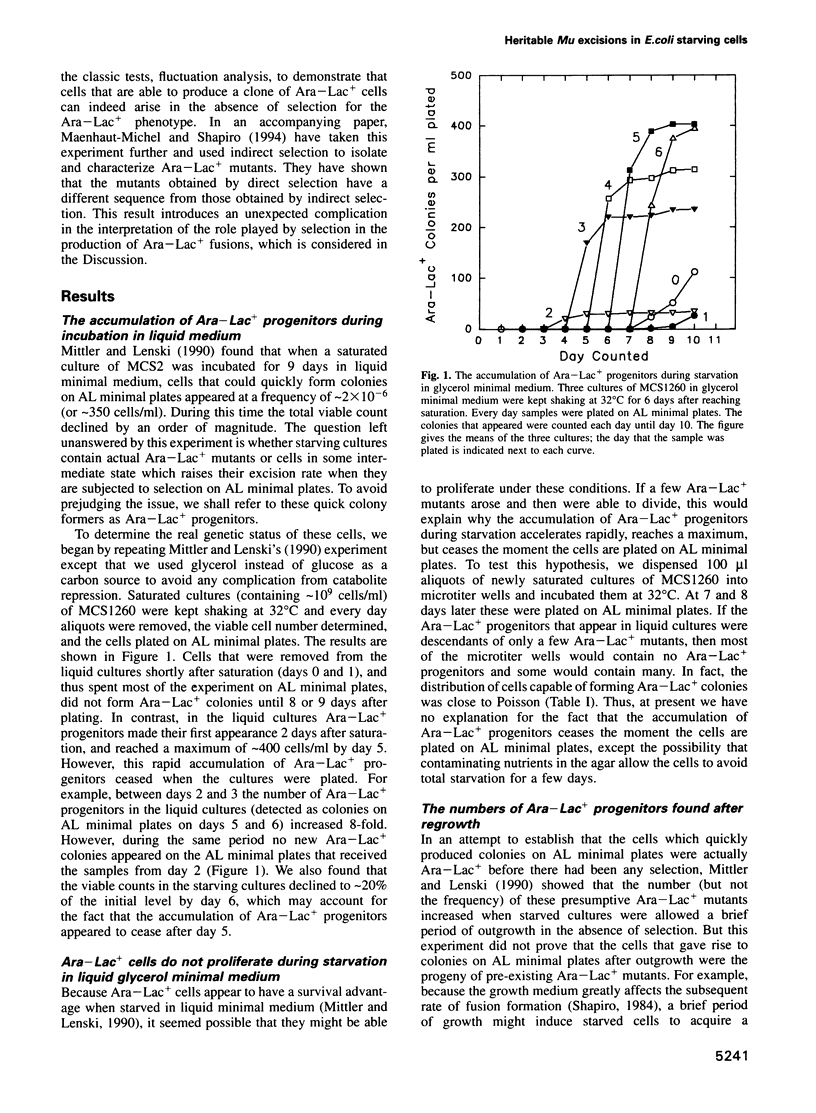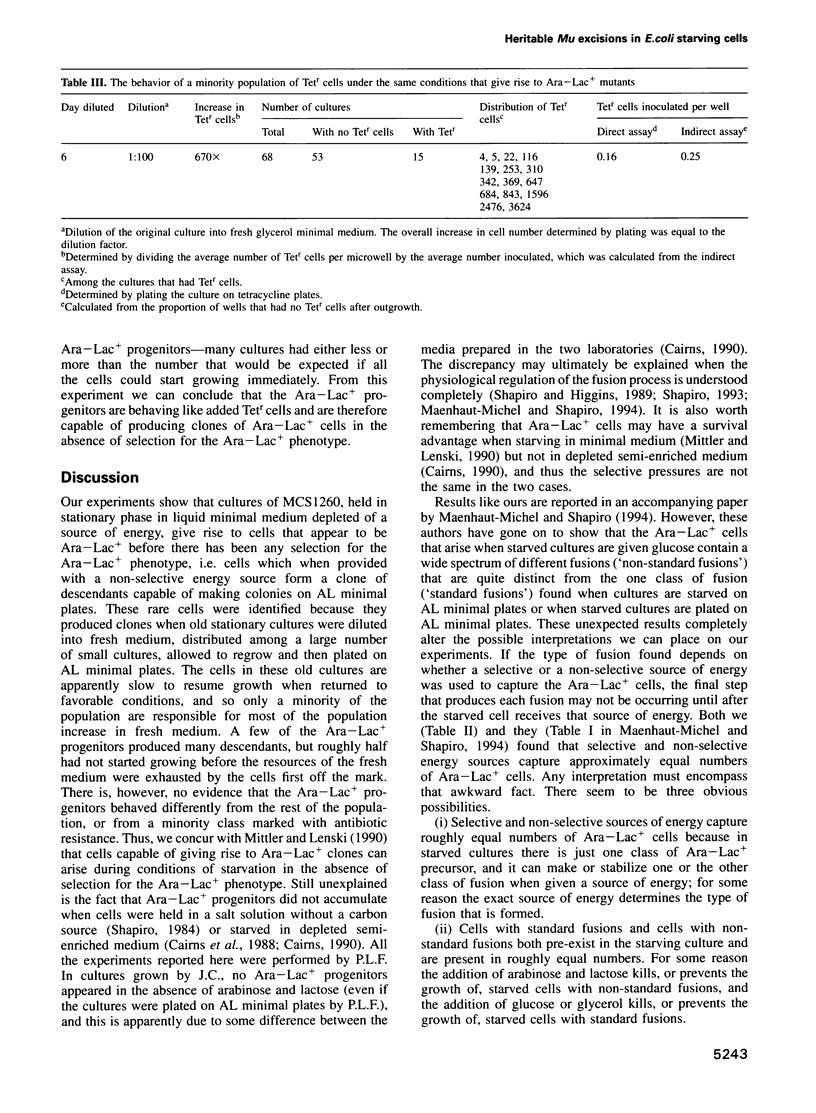Abstract
A strain of Escherichia coli constructed by Shapiro has a segment of Mu bacteriophage DNA inserted between the araC and lacZ genes. Excision events that produce an in-frame fusion of lacZ to araB result in a cell (here designated Ara-Lac+) that can grow on lactose if arabinose is present as an inducer. Whether or not these excision events occur in the absence of selection for the Ara-Lac+ phenotype has figured prominently in the debate of the phenomenon known as 'directed' or 'adaptive' mutation. In an attempt to settle the issue, we have used classic fluctuation tests to show that cells capable of producing a clone of descendants that are phenotypically Ara-Lac+ do, indeed, arise in stationary phase cultures kept starving in depleted minimal medium. We found that Ara-Lac+ progenitors arise rapidly under these conditions, in contrast to the delayed appearance of Ara-Lac+ mutants when cells are incubated on lactose-arabinose minimal plates. Similar results are reported in the accompanying paper by Maenhaut-Michel and Shapiro, who used indirect selection to isolate Ara-Lac+ cells in the absence of selection. However, their sequencing data have introduced a new unexpected complication to the interpretation of all such experiments, and it is no longer clear exactly when the fusions arise.
Full text
PDF




Selected References
These references are in PubMed. This may not be the complete list of references from this article.
- Arber W., Iida S., Jütte H., Caspers P., Meyer J., Hänni C. Rearrangements of genetic material in Escherichia coli as observed on the bacteriophage P1 plasmid. Cold Spring Harb Symp Quant Biol. 1979;43(Pt 2):1197–1208. doi: 10.1101/sqb.1979.043.01.136. [DOI] [PubMed] [Google Scholar]
- Cairns J. Causes of mutation and mu excision. Nature. 1990 May 17;345(6272):213–213. doi: 10.1038/345213a0. [DOI] [PubMed] [Google Scholar]
- Cairns J., Foster P. L. Adaptive reversion of a frameshift mutation in Escherichia coli. Genetics. 1991 Aug;128(4):695–701. doi: 10.1093/genetics/128.4.695. [DOI] [PMC free article] [PubMed] [Google Scholar]
- Cairns J., Overbaugh J., Miller S. The origin of mutants. Nature. 1988 Sep 8;335(6186):142–145. doi: 10.1038/335142a0. [DOI] [PubMed] [Google Scholar]
- Cavalli-Sforza L L, Lederberg J. Isolation of Pre-Adaptive Mutants in Bacteria by Sib Selection. Genetics. 1956 May;41(3):367–381. doi: 10.1093/genetics/41.3.367. [DOI] [PMC free article] [PubMed] [Google Scholar]
- Hall B. G. Adaptive evolution that requires multiple spontaneous mutations. I. Mutations involving an insertion sequence. Genetics. 1988 Dec;120(4):887–897. doi: 10.1093/genetics/120.4.887. [DOI] [PMC free article] [PubMed] [Google Scholar]
- Hall B. G. On alternatives to selection-induced mutation in the Bgl operon of Escherichia coli. Mol Biol Evol. 1994 Mar;11(2):159–168. doi: 10.1093/oxfordjournals.molbev.a040100. [DOI] [PubMed] [Google Scholar]
- Hall B. G. Spontaneous point mutations that occur more often when advantageous than when neutral. Genetics. 1990 Sep;126(1):5–16. doi: 10.1093/genetics/126.1.5. [DOI] [PMC free article] [PubMed] [Google Scholar]
- LEDERBERG J., LEDERBERG E. M. Replica plating and indirect selection of bacterial mutants. J Bacteriol. 1952 Mar;63(3):399–406. doi: 10.1128/jb.63.3.399-406.1952. [DOI] [PMC free article] [PubMed] [Google Scholar]
- Leach D., Symonds N. The isolation and characterisation of a plaque-forming derivative of bacteriophage Mu carrying a fragment of Tn3 conferring ampicillin resistance. Mol Gen Genet. 1979 May 4;172(2):179–184. doi: 10.1007/BF00268280. [DOI] [PubMed] [Google Scholar]
- Lenski R. E., Mittler J. E. The directed mutation controversy and neo-Darwinism. Science. 1993 Jan 8;259(5092):188–194. doi: 10.1126/science.7678468. [DOI] [PubMed] [Google Scholar]
- Luria S. E., Delbrück M. Mutations of Bacteria from Virus Sensitivity to Virus Resistance. Genetics. 1943 Nov;28(6):491–511. doi: 10.1093/genetics/28.6.491. [DOI] [PMC free article] [PubMed] [Google Scholar]
- Maenhaut-Michel G., Shapiro J. A. The roles of starvation and selective substrates in the emergence of araB-lacZ fusion clones. EMBO J. 1994 Nov 1;13(21):5229–5239. doi: 10.1002/j.1460-2075.1994.tb06854.x. [DOI] [PMC free article] [PubMed] [Google Scholar]
- Mittler J. E., Lenski R. E. Experimental evidence for an alternative to directed mutation in the bgl operon. Nature. 1992 Apr 2;356(6368):446–448. doi: 10.1038/356446a0. [DOI] [PubMed] [Google Scholar]
- Mittler J. E., Lenski R. E. New data on excisions of Mu from E. coli MCS2 cast doubt on directed mutation hypothesis. Nature. 1990 Mar 8;344(6262):173–175. doi: 10.1038/344173a0. [DOI] [PubMed] [Google Scholar]
- Naas T., Blot M., Fitch W. M., Arber W. Insertion sequence-related genetic variation in resting Escherichia coli K-12. Genetics. 1994 Mar;136(3):721–730. doi: 10.1093/genetics/136.3.721. [DOI] [PMC free article] [PubMed] [Google Scholar]
- Pfeifer F., Blaseio U. Transposition burst of the ISH27 insertion element family in Halobacterium halobium. Nucleic Acids Res. 1990 Dec 11;18(23):6921–6925. doi: 10.1093/nar/18.23.6921. [DOI] [PMC free article] [PubMed] [Google Scholar]
- Shapiro J. A. A role for the Clp protease in activating Mu-mediated DNA rearrangements. J Bacteriol. 1993 May;175(9):2625–2631. doi: 10.1128/jb.175.9.2625-2631.1993. [DOI] [PMC free article] [PubMed] [Google Scholar]
- Shapiro J. A., Higgins N. P. Differential activity of a transposable element in Escherichia coli colonies. J Bacteriol. 1989 Nov;171(11):5975–5986. doi: 10.1128/jb.171.11.5975-5986.1989. [DOI] [PMC free article] [PubMed] [Google Scholar]
- Shapiro J. A., Leach D. Action of a transposable element in coding sequence fusions. Genetics. 1990 Oct;126(2):293–299. doi: 10.1093/genetics/126.2.293. [DOI] [PMC free article] [PubMed] [Google Scholar]
- Shapiro J. A. Observations on the formation of clones containing araB-lacZ cistron fusions. Mol Gen Genet. 1984;194(1-2):79–90. doi: 10.1007/BF00383501. [DOI] [PubMed] [Google Scholar]
- Singer M., Baker T. A., Schnitzler G., Deischel S. M., Goel M., Dove W., Jaacks K. J., Grossman A. D., Erickson J. W., Gross C. A. A collection of strains containing genetically linked alternating antibiotic resistance elements for genetic mapping of Escherichia coli. Microbiol Rev. 1989 Mar;53(1):1–24. doi: 10.1128/mr.53.1.1-24.1989. [DOI] [PMC free article] [PubMed] [Google Scholar]
- Stahl F. W. Bacterial genetics. A unicorn in the garden. Nature. 1988 Sep 8;335(6186):112–113. doi: 10.1038/335112a0. [DOI] [PubMed] [Google Scholar]
- Tormo A., Almirón M., Kolter R. surA, an Escherichia coli gene essential for survival in stationary phase. J Bacteriol. 1990 Aug;172(8):4339–4347. doi: 10.1128/jb.172.8.4339-4347.1990. [DOI] [PMC free article] [PubMed] [Google Scholar]


